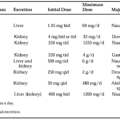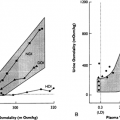ACTIONS OF GROWTH HORMONE
Growth hormone has numerous biologic actions, many occurring in concert to enhance protein anabolism and tissue accretion. GH can act directly as well as indirectly through IGF-I, also known as somatomedin C. The mitogenic and proliferative actions of GH are mediated through IGF-I, whereas some of the metabolic actions are direct GH effects. GH has no specific target organ; it acts on most if not all tissues through the ubiquitously expressed GHR.
INSULIN-LIKE GROWTH FACTORS AND THEIR BINDING PROTEINS
The existence of GH-dependent factors that might mediate the action of GH was first suggested by the report that SO4 incorporation into growth cartilage chondroitin sulfate was reduced by hypophysectomy, but that exposure of cartilage to GH in vitro could not correct the abnormality. In contrast, serum from animals treated with GH was highly effective in restoring SO4 uptake, implicating a GH-dependent “sulfation factor.”27 Sulfation factor was later renamed somatomedin, and the “somatomedin hypothesis” was born. It soon became clear that somatomedin was identical to “nonsuppressible insulin-like activity,” which led to the characterization of IGF-I and IGF-II. The IGFs are proinsulin-like molecules that are produced in many tissues in response to GH and other regulators. IGF-I production is highly GH-dependent, whereas IGF-II production is less dependent on GH. IGFs act both locally in a paracrine/autocrine fashion and distantly in a hormone-like mode. They have mitogenic and metabolic activities and act through the type I IGF receptor, which is structurally similar to the insulin receptor. Six binding proteins for IGF (IGFBP) are present in serum and interstitial fluid; they may either enhance or decrease IGF activity.28 In addition, three IGFBP-related proteins bind IGFs with low affinity,29 for a total of nine proteins in the IGFBP family. IGFBP-1 is insulin dependent and has primarily inhibitory activity in vivo. IGFBP-2 is inversely GH dependent; its biologic role is incompletely understood. IGFBP-3 is the major IGFBP in serum; it is highly GH dependent, and it serves primarily to retain IGFs in the circulation by forming a 150-kDa ternary complex involving IGF, IGFBP-3, and another GH-dependent protein called acid-labile subunit (ALS). This complex is responsible for the high IGF concentrations in serum and serves as a circulating IGF reservoir. Most of the circulating IGF is bound in this complex. IGFBP-4, IGFBP-5, and IGFBP-6 are in part associated with the extracellular matrix and modulate IGF action through restricting or enhancing IGF access to the IGF receptor. IGFBP structure and activity is modulated by proteases that cleave the IGFBPs, thereby decreasing IGF-binding affinity. Protease activity is regulated by a variety of physiologic and pathologic conditions. IGFBPs and their fragments may have activities of their own (such as antianabolic activity) that are independent of their IGF-binding properties. A full description of the complex IGF-IGFBP system is beyond the scope of this chapter; from a clinical standpoint, an understanding of IGFBP-3 and IGFBP-2 is most important because they can be used diagnostically.
Stay updated, free articles. Join our Telegram channel

Full access? Get Clinical Tree







